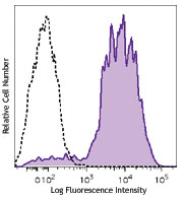-
Sign In
-

-
 Sony Biotechnology
Sony Biotechnology
-

-
 Sony Biotechnology
Sony Biotechnology
Brilliant Violet 711™ anti-mouse/human CD11b
Antibodies Single
Sony
M1/70
Flow Cytometry
Rat IgG2b, κ
Human
C57BL/10 splenocytes
1106205
$220.00
Description
CD11b is a 170 kD glycoprotein also known as αM integrin, Mac-1 α subunit, Mol, CR3, and Ly-40. CD11b is a member of the integrin family, primarily expressed on granulocytes, monocytes/macrophages, dendritic cells, NK cells, and subsets of T and B cells. CD11b non-covalently associates with CD18 (β2 integrin) to form Mac-1. Mac-1 plays an important role in cell-cell interaction by binding its ligands ICAM-1 (CD54), ICAM-2 (CD102), ICAM-4 (CD242), iC3b, and fibrinogen.
Formulation
Phosphate-buffered solution, pH 7.2, containing 0.09% sodium azide and BSA (origin USA).Recommended Usage
Each lot of this antibody is quality control tested by immunofluorescent staining with flow cytometric analysis. For immunofluorescent staining using the microg size, the suggested use of this reagent is ≤0.4 microg per million cells in 100 microL volume. For immunofluorescent staining using the microL size, the suggested use of this reagent is ≤5 microL per million cells or 5 microL per 100 microL of whole blood. It is recommended that the reagent be titrated for optimal performance for each application.
Brilliant Violet 711™ excites at 405 nm and emits at 711 nm. The bandpass filter 710/50 nm is recommended for detection, although filter optimization may be required depending on other fluorophores used. Be sure to verify that your cytometer configuration and software setup are appropriate for detecting this channel. Refer to your instrument manual or manufacturer for support. Brilliant Violet 711™ is a trademark of Sirigen Group Ltd.
This product is subject to proprietary rights of Sirigen Inc. and is made and sold under license from Sirigen Inc. The purchase of this product conveys to the buyer a non-transferable right to use the purchased product for research purposes only. This product may not be resold or incorporated in any manner into another product for resale. Any use for therapeutics or diagnostics is strictly prohibited. This product is covered by U.S. Patent(s), pending patent applications and foreign equivalents.
References
1. Springer T, et al. 1978. Eur. J. Immunol. 8:539. (IP)
2. Ault K and Springer T. 1981. J. Immunol. 126:359. (Deplete)
3. Springer TA, et al. 1982. Immunol. Rev. 68:171. (Block)
4. Ho MK and Springer TA. 1983. J. Biol. Chem. 258:2766. (IP)
5. Flotte TJ, et al. 1983. Am. J. Pathol. 111:112. (IHC)
6. Noel GJ, et al. 1990. J. Clin. Invest. 85:208. (IF)
7. Allen LA and Aderem A. 1996. J. Exp. Med. 184:627 (IF)
8. D'Amico A and Wu L. 2003. J. Exp. Med. 198:293. (Deplete)
9. Brickson SJ, et al. 2003. Appl Physiol. 95:969. (Block)
10. Clatworthy MR and Smith KG. 2004. J. Exp. Med. 199:717. (IF)
11. Hata H, et al. 2004. J. Clin. Invest. 114:582. (IHC)
12. Zhang Y, et al. 2002. J. Immunol. 168:3088. (IHC)
13. Iwasaki A and Kelsall BL. 2001. J. Immunol. 166:4884 (IHC, FC)
14. Tailleux L. 2003. J. Exp. Med. 197:121. (Block, FC)
15. Olver S, et al. 2006. Cancer Research 66:571. (FC)
16. Tan SL, et al. 2006. J. Immunol. 176:2872. (FC) PubMed
17. Ponomarev ED, et al. 2006. J. Immunol. 176:1402. (FC)
18. Dzhagalov I, et al. 2007. Blood 109:1620. (FC)
19. Fazilleau N, et al. 2007. Nature Immunol. 8:753.
20. Rasmussen JW, et al. 2006. Infect. Immun.74:6590. PubMed
21. Napimoga MH, et al. 2008. J. Immunol. 180:609. PubMed
22. Elqaraz-Carmon V, et al. 2008. J. Lipid. Res. 49:1894. PubMed
23. Kim DD, et al. 2008. Blood 112:1109. PubMed
24. Guo Y, et al. 2008. Blood 112:480. PubMed
25. Norian LA, et al. 2009. Cancer Res. 69:3086. (FC) PubMed
26. Baumgartner CK, et al. 2010. J. Immunol. 184:573. PubMed
27. Charles N, et al. 2010. Nat. Med. 16:701. (FC) PubMed
28. Whiteland J, et al. 1995. J. Histochem. Cytochem. 43:313. (IHC)


